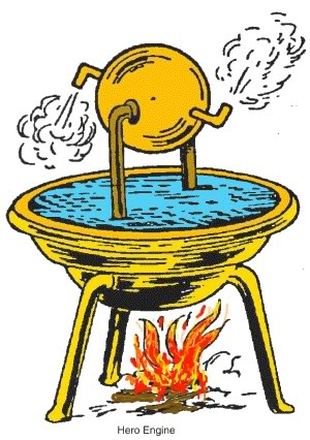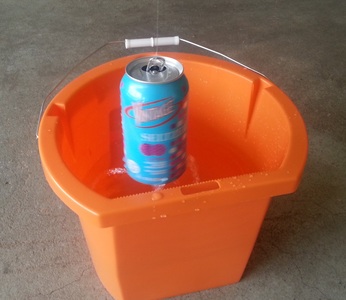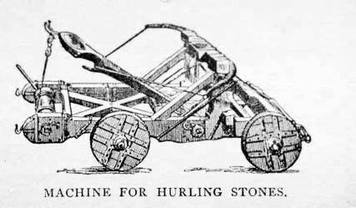Experimenting with the Laws of Motion  This week in class we investigated the physics of motion by recreating a simplified version of a very famous invention - Hero of Alexandria's aeolipile, or "steam ball". As students have read in our text, Hero was a designer of many ingenious and whimsical inventions. The aeolipile is perhaps his most notable work because it is considered to be the first recorded steam engine or reaction steam turbine - developed many thousands of years before the Industrial Revolution. The sphere had bent nozzles projecting from its sides, angled up and down (for opposing forces). When heated from below, steam would shoot out through the nozzles resulting in thrust that would then cause the sphere to spin. Before beginning our experimentation, we took some time to review Newton's 3 Laws of Motion. Of course, Newton would not develop his Universal Law of Gravitation or these Laws of Motion until the 17th century. However, Hero's work clearly demonstrated these laws many hundreds of years earlier. Pop Can Hero!  Students simulated the operation of a classic aeolipile by constructing water-propelled engines out of soft drink cans. Specifically, they investigated ways to increase the action-reaction thrust produced by water shooting out of holes punched in the sides of the can. After an initial demonstration of how to generate spin by punching angled holes in the can with nails (Newtons 3rd Law of motion), the class spent some time speculating on what variables might increase the number of pop can rotations. The class came up with three variables to test: 1) number of holes, 2) size of holes and 3) placement of holes. They then split into three teams, with each team assigned one variable to test. Teams developed their hypothesis and their testing procedures using the experiment worksheet, and then began building their engines (each team built three engines to test various designs). We discussed the importance of creating a baseline and then changing only one variable at a time. Interestingly, all three teams formulated correct hypotheses: 1) that fewer holes would result in more rotations because the water pressure would remain higher for longer, allowing the water to drain out more slowly, 2) that smaller sized holes would also result in a greater pressure and therefore a greater number of rotations, and 3) that placement of holes at the base of the can (versus higher up) would result in a greater number of rotations. Although the team results did point toward verified hypotheses, the results of all teams were not conclusive. One additional factor that students discovered was the importance of keeping the length of the string (we used fishing line) constant for each engine tested. A twisting force added by a longer or shorter string can modify the number of can rotations. Also, several teams were able to get very high accelerations of spin, which made it difficult to accurately count the number of rotations. While students found it somewhat unsatisfying to have inconclusive results, this opened up the opportunity to discuss possible modifications to our experimental design, and the need for further testing - all important aspects of real world scientific investigation! Catapults and Homework  Continuing our study of the physics of machines, students were given supplies and instructions for building and testing a simple catapult at home. I have encouraged them to include siblings and family members in this project - it's fun and really lends itself to multi-age learning. Please make sure to complete the catapult homework sheet and bring it back to class next week with your catapult. Students should also read Chapter 17 on Archimedes in preparation for next weeks class discussion and projects. Comments are closed.
|
Categories
All
Archives
May 2016
|

 RSS Feed
RSS Feed